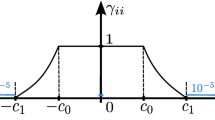Abstract
Reliability testing, namely receiver autonomous integrity monitoring (RAIM), consists of statistical testing of least-squares residuals of observations, e.g., on an epoch-by-epoch basis aiming towards reliable navigation fault detection and exclusion (FDE). In this paper, classic RAIM and FDE methods are extended with testing of range-rate residuals to find inconsistent velocity solutions in order to contribute to the reliability of the system with special focus on degraded signal environments. Reliability enhancement efforts discussed include a Backward-FDE scheme based on statistical outlier detection and an iteratively reweighted robust estimation technique, a modified Danish method. In addition, measurement weighting assigned to code and Doppler observations is assessed in the paper in order to allow fitting a priori variance models to the estimation processes. The schemes discussed are also suitable in terms of computational convenience for a combined GPS/Galileo system. The objective of this paper is to assess position and velocity reliability testing and enhancement in urban and indoor conditions and to analyze the navigation accuracy conditions with high sensitivity GPS (HSGPS) tests. The results show the necessity of weighted estimation and FDE for reliability enhancement in degraded signal-environment navigation.















Similar content being viewed by others
References
Baarda W (1968) A testing procedure for use in geodetic networks. Netherlands Geodetic Commission, Publication on Geodesy, New Series 2, 5, Delft, Netherlands, pp 1–97
Brown RG (1992) A baseline RAIM scheme and a note on the equivalence of three RAIM methods. In: Proceedings of ION NTM 1992, The Institute of Navigation, pp 127–138
Caspary WF (1988) Concepts of network and deformation analysis. UNSW, Australia, School of Surveying, Monograph 11:1–183
Hartinger H, Brunner FK (1999) Variances of GPS phase observations: the SIGMA-ɛ model. GPS Solutions 2(4):35–43
Hawkins DM (1980) Identification of Outliers. Chapman and Hall, London, pp 1–188
Jørgensen PC, Kubik K, Frederiksen P, Weng W (1985) Ah, robust estimation! Aust J Geod Photogram Surv 42:19–32
Kaplan ED (ed) (1996) Understanding GPS: principles and applications. Artech House Inc., pp 1–554
Kuang S (1996) Geodetic network analysis and optimal design. Ann Arbor Press, Chelsea, pp 1–368
Kuusniemi H, Lachapelle G (2004) GNSS signal reliability testing in urban and indoor environments. In: Proceedings of ION NTM 2004. The Institute of Navigation, pp 210–224
Lachapelle G, Kuusniemi H, Dao DTH, MacGougan G, Cannon ME (2003) HSGPS signal analysis and performance under various indoor conditions. In: Proceedings of ION GPS 2003. The Institute of Navigation, pp 1171–1184
Leick A (2004) GPS Satellite Surveying, 3rd edn. Wiley, New York, pp 1–435
Lu G (1991) Quality control for differential kinematic GPS positioning. Master’s Thesis, University of Calgary, UCGE Report 20042, pp 1–103
MacGougan G, Lachapelle G, Klukas R, Siu K, Garin L, Shewfelt J, Cox G (2002) Performance analysis of a stand-alone high sensitivity receiver. GPS Solutions 6(3):179–195
Ober PB (2003) Integrity prediction and monitoring of navigation systems. PhD Thesis, Delft University of Technology, Integricom Publishers, The Netherlands, pp 1–146
Parkinson BW, Spilker JJ (ed) (1996) Global positioning system: theory and applications, vol 1 and 2. AIAA Inc., pp 1–793 and pp 1–643
Petovello MG (2003) Real-time integration of a Tactical-Grade IMU and GPS for high-accuracy positioning and navigation. PhD Thesis, University of Calgary, UCGE Report 20173, pp 1–242
Rousseeuw PJ, Leroy AM (1987) Robust regression and outlier detection. Wiley, New York, pp 1–329
Ryan S (2002) Augmentation of DGPS for marine navigation. PhD Thesis, The University of Calgary, UCGE Report 20164, pp 1–248
Teunissen PJG (1998) Quality control and GPS. In: Teunissen PJG, Kleusberg A (eds) GPS for Geodesy, 2nd edn. Springer, Berlin Heidelberg, New York, pp 271–318
Van Graas F, Farrell JL (1993) Baseline fault detection and exclusion algorithm. In: Proceedings of ION AM 1993. The Institute of Navigation, pp 413–420
Wieser A (2001) Robust and fuzzy techniques for parameter estimation and quality assessment in GPS. PhD Thesis, TU Graz, pp 1–253
Wieser A, Brunner FK (2000) An extended weight model for GPS phase observations. Earth Planets Space 52:777–782
Acknowledgements
The authors would like to thank Dr. A. Wieser and Ms. Diep Dao from the University of Calgary, Canada for their effort. The Nokia Foundation, the National Technology Agency of Finland, and the Graduate School of Electronics, Telecommunications, and Automation are acknowledged for financial support and SiRF Technologies Inc. for providing the test equipment.
Author information
Authors and Affiliations
Corresponding author
Rights and permissions
About this article
Cite this article
Kuusniemi, H., Lachapelle, G. & Takala, J.H. Position and velocity reliability testing in degraded GPS signal environments. GPS Solutions 8, 226–237 (2004). https://doi.org/10.1007/s10291-004-0113-7
Received:
Accepted:
Published:
Issue Date:
DOI: https://doi.org/10.1007/s10291-004-0113-7




